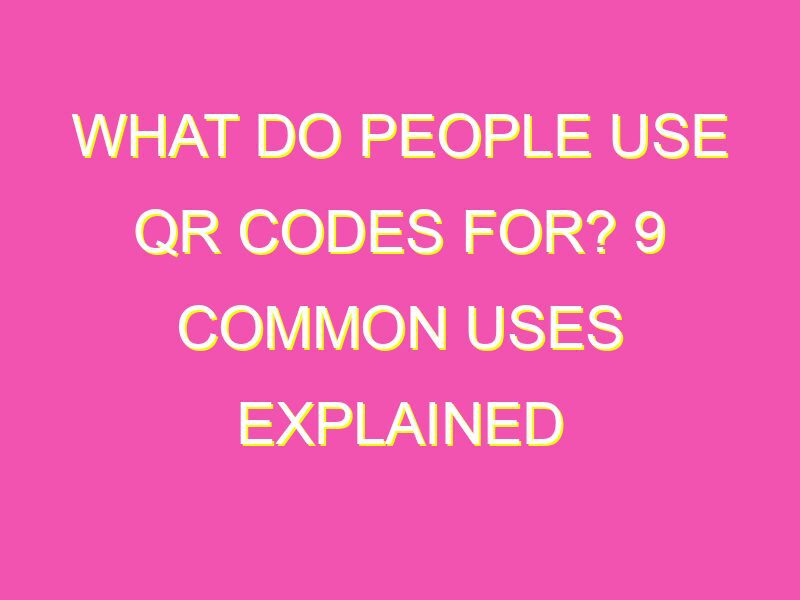QR codes are revolutionising the way we share information and complete transactions. Here are some of the most common and convenient uses:
In conclusion, QR codes are a versatile and convenient tool for individuals and businesses alike. Say hello to effortless information sharing and secure transactions.
Understanding QR Codes: A Brief Overview
QR codes, short for Quick Response codes, are a two-dimensional symbology that encodes information in a readable format for machines. They were first developed in the automotive industry by Denso Wave in 1994 and were initially used to help manage inventory. However, QR codes slowly made their way into mainstream use, particularly after the boom in smartphone usage. Today, they are extensively used in various sectors, including marketing, payment processing, and sharing contact information.
QR Code Functionality: How do QR Codes work?
QR codes function by encoding a message in a matrix of black and white squares. The squares are arranged in a specific pattern, and the positioning of the squares determines the encoded message. Smartphones equipped with a camera and a QR code reader app can scan the code, interpret the encoded message, and direct the user to its intended destination, be it a website, contact information, or a payment platform.
The Use of QR Codes in Sharing Hyperlinks to Websites
QR codes have proven to be a useful tool in sharing hyperlinks to various websites. Instead of a user having to type in the URL, the QR code can be scanned, and the user will be redirected to the desired website. This functionality can be helpful for businesses that want to ensure quick and easy access to their online platforms. A company can place a QR code on a product pack or accompanying documentation, saving users from having to type in the website address and making the brand more accessible.
Did You Know?
- QR codes can include hidden promotional codes, sales messages, or discounts that are revealed once the user reaches the destination website.
- A recent study by QR Code Generator found that the most common use for QR codes was to direct people to a website (53%) followed by sharing contact information (34%).
- Although there are many free QR code generator tools available online, it is crucial to make sure that privacy is protected and safety measures are in place.
Sharing Contact Information through QR Codes: A Convenient Option
QR codes offer a more practical method of exchanging contact information. Instead of having two parties physically share cards, contact information can be exchanged by scanning a code. By scanning a QR code, a user can instantly save a contact’s information into their device’s contacts list. Additionally, businesses can use QR codes to provide potential customers or partners their contact information quickly, helping to improve engagement or drive sales.
QR Codes for Payments: The Future of Transactions?
QR codes have become increasingly common in digital payment processes. QR codes offer a quicker transaction experience, and the cost of the required infrastructure is minimal. One significant advantage to using QR codes for payments is that the transaction details are sent directly to the user’s phone, allowing for tracking and easy record keeping. Additionally, using QR codes for payments can reduce security risks that come with traditional card processing as QR codes can be made to be secured and highly encrypted, making it challenging for cybercriminals to infiltrate.
QR Codes in Marketing: A New Era of Advertising
QR codes offer marketers an alternative and versatile way to promote products or services. Unlike traditional advertising methods, such as billboards, QR codes offer a more personalized approach as they allow brands to interact with customers directly. Additionally, QR codes offer companies the ability to track who scanned the code, when, and where. This functionality allows brands to analyze their audience, better understand their target market, and create more tailored campaigns.
Fun Fact:
- A 2019 study found that QR code usage in print advertising has spiked dramatically between 2018 and2019 by 30%, driven largely by millennial and Gen Z adoption.
- Some brands have begun integrating QR codes into their merchandise, offering new ways of interacting with their customers. Some examples include embedding QR Codes into insoles or t-shirts, adding a fun, inventive and interactive aspect to transactions.
- Brands that integrate QR codes into their marketing campaigns report up to a 20% increase in scan rates when compared to text-style links.
The Limitations and Risks of QR Codes: What You Need to Know
While QR codes are convenient and seemingly innocuous, they can also present security risks. For instance, cybercriminals can manipulate QR codes to direct users to phishing websites or other malicious destinations. Additionally, QR codes can be made to carry out harmful functions such as downloading malware on a device upon scanning. Moreover, not every device contains a built-in QR code reader, which means some users may have to download a third-party app to scan the code, causing friction in the user experience.
In conclusion, QR codes are proving to be more than just a passing tech trend. They offer actionable and practical methods of sharing and conveying information, promoting businesses, and even making transactions. They will continue to evolve and make progress in bringing the advantages of the digital world within easy reach, however it’s essential to remain cautious of the security risks and vulnerabilities they can pose. As long as users remain vigilant and maintain proper cybersecurity measures, QR codes can revolutionize how we interact with the digital world.





